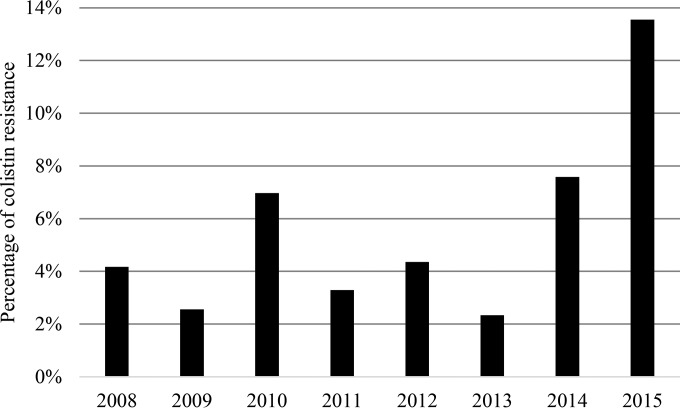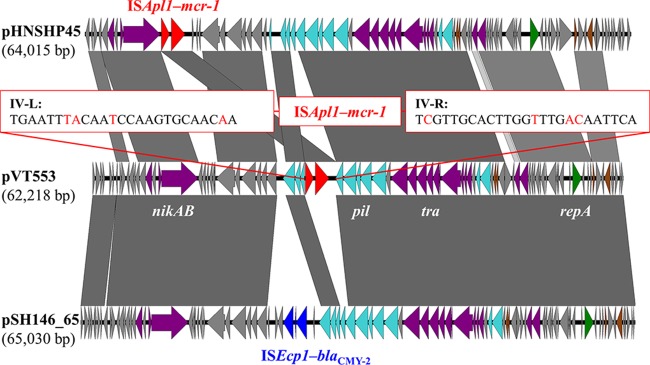LETTER
Since the first report of the plasmid-mediated colistin resistance gene mcr-1 in November 2015 in China (1), several studies have confirmed its worldwide spread in different animal and human environments (2, 3). The routes of dissemination of mcr-1 have been associated with travelers and trading of food animals (4, 5). Nevertheless, the presence of this gene and of the type of mediating plasmids in sub-Saharan Africa in avian-pathogenic Escherichia coli (APEC) causing airsacculitis in broiler chickens has not yet been reported.
In South Africa, antimicrobial treatment against APEC has become challenging due to the increased number of strains resistant to multiple antimicrobials. In order to provide targeted therapy, MICs of colistin have been determined for a total of 4,934 E. coli isolates from air sac lesions in different broiler operations since 2008 using the Müller-Hinton broth microdilution method (Deltamune [Pty] Ltd., Lyttelton, South Africa). The number of E. coli isolates with a MIC of colistin of ≥4 μg/ml has significantly increased from an average of 4.5% for the years 2008 to 2014 to 13.6% in 2015 (P < 0.05, Dunn's test) (Fig. 1).
FIG 1.
Evolution of colistin resistance (MIC, ≥4 μg/ml) in avian-pathogenic E. coli in South Africa from 2008 to 2015. The number of colistin-resistant isolates and the overall number of isolates tested each year were as follows: 2008, 2 of 48; 2009, 10 of 391; 2010, 17 of 244; 2011, 16 of 686; 2012, 30 of 688; 2013, 24 of 1,027; 2014, 95 of 1,253; 2015, 108 of 797.
The mcr-1 gene has been sought by PCR in strains isolated in the last quarter of 2015 (1). Out of 20 of 108 colistin-resistant E. coli isolates among 797 strains of 2015, 19 contained mcr-1. These strains originated from 6 geographically distant broiler operations and exhibited 18 different repetitive element palindromic PCR (rep-PCR) profiles (6) (see Table S1 in the supplemental material). Whole-plasmid sequence of strain VT55363 was obtained using the MiSeq Reagent kit v2 (Illumina Inc.) (Labormedizinisches Zentrum Dr Risch, Bern-Liebefeld, Switzerland), and the circular form was closed by PCR and subsequent Sanger sequencing. While the mcr-1-containing element (ISApl1–mcr-1) of the 62,218-bp plasmid pVT553 was identical to that present on pHNSHP45 (accession no. KP347127) originally reported in a pig from China, the two plasmids were not structurally related. Plasmid pVT553 shared 96% identity to plasmid pSH146_65 originally detected in Salmonella enterica subsp. enterica serovar Heidelberg sequenced in the United States (accession no. JN983044). Plasmids pVT553 and pSH146_65 belonged to incompatibility group IncI2 and shared the same backbone except for the insertion of the ISApl1–mcr-1 element in pVT553 and a blaCMY-2-containing element (ISEcp1–blaCMY-2) in pSH146_65 (Fig. 2). Insertion of ISApl1–mcr-1 occurred within the pil region of pVT553, deleting pilS, essential for pilus formation (7), explaining the absence of conjugative transfer into E. coli strain JF33 (Rifr) as tested by filter mating and selection on Müller-Hinton agar containing 50 μg/ml rifampin and 4 μg/ml colistin. Strain VT55363 belonged to sequence type (ST) 3640 (mlst.warwick.ac.uk) and also contained genes conferring resistance to tetracycline [tet(A)], sulfonamides (sul3), trimethoprim (dfrA12), and streptomycin (aadA1, strA, and strB), which were not located on pVT553. The MICs of 15 additional antibiotics were tested for the 20 investigated strains using EUVSEC Sensititre plates (Thermo Fisher Scientific Inc.) (see Table S1 in the supplemental material).
FIG 2.
Schematic presentation of the colistin resistance plasmid pVT553 from APEC from South Africa (GenBank accession no. KU870627) compared to the colistin resistance plasmid pHNSHP45 from E. coli (accession no. KP347127) and to the β-lactam resistance plasmid pSH146_65 from Salmonella enterica subsp. enterica serovar Heidelberg (accession no. JN983044). The integrated colistin resistance element ISApl1–mcr-1 is in red, and ISEcp1–blaCMY-2 is in blue. Integration sites of the ISApl1–mcr-1 element in pVT553 are indicated with the sequences. Transfer-associated genes are purple, genes for plasmid stability are in brown, genes for type IV pilus formation are in turquoise, and the replication gene repA is in green. The figure was created using Easyfig (mjsull.github.io).
Plasmid pVT553 represents a novel element carrying mcr-1 and gives a first insight into the type of mcr-1 plasmids present in APEC in South Africa. Moreover, the presence of mcr-1 in APEC emphasizes the importance of preventing global overuse and misuse of colistin. It is imperative that colistin be used only in intensive livestock production units upon a diagnosis by a veterinarian, after a MIC result, when the mcr-1 status of the operation is known, or in special cases, when no alternatives are available, and never in subinhibitory concentrations. These measures as well as extensive surveillance programs of antibiotic resistance should be extended to pig and cattle farms, and in human medicine, since mcr-1 has also been recently detected in human isolates in South Africa (8). Restrictive use of colistin is essential to prevent the rapid spread of mcr-1 to other bacteria and in different animal settings, the food chain, and human hospitals.
Nucleotide sequence accession number.
The sequence of the 62,218-bp plasmid pVT553 containing the ISApl1–mcr-1 element has been submitted to GenBank under accession number KU870627.
Supplementary Material
Footnotes
Supplemental material for this article may be found at http://dx.doi.org/10.1128/AAC.00548-16.
REFERENCES
- 1.Liu YY, Wang Y, Walsh TR, Yi LX, Zhang R, Spencer J, Doi Y, Tian G, Dong B, Huang X, Yu LF, Gu D, Ren H, Chen X, Lv L, He D, Zhou H, Liang Z, Liu JH, Shen J. 2016. Emergence of plasmid-mediated colistin resistance mechanism MCR-1 in animals and human beings in China: a microbiological and molecular biological study. Lancet Infect Dis 16:161–168. doi: 10.1016/S1473-3099(15)00424-7. [DOI] [PubMed] [Google Scholar]
- 2.Du H, Chen L, Tang YW, Kreiswirth BN. 2016. Emergence of the mcr-1 colistin resistance gene in carbapenem-resistant Enterobacteriaceae. Lancet Infect Dis 16:287–288. doi: 10.1016/S1473-3099(16)00056-6. [DOI] [PubMed] [Google Scholar]
- 3.Hasman H, Hammerum AM, Hansen F, Hendriksen RS, Olesen B, Agerso Y, Zankari E, Leekitcharoenphon P, Stegger M, Kaas RS, Cavaco LM, Hansen DS, Aarestrup FM, Skov RL. 2015. Detection of mcr-1 encoding plasmid-mediated colistin-resistant Escherichia coli isolates from human bloodstream infection and imported chicken meat, Denmark 2015. Euro Surveill 20(49). doi: 10.2807/1560-7917.ES.2015.20.49.30085. [DOI] [PubMed] [Google Scholar]
- 4.Grami R, Mansour W, Mehri W, Bouallegue O, Boujaafar N, Madec JY, Haenni M. 2016. Impact of food animal trade on the spread of mcr-1-mediated colistin resistance, Tunisia, July 2015. Euro Surveill 21(8). doi: 10.2807/1560-7917.ES.2016.21.8.30144. [DOI] [PubMed] [Google Scholar]
- 5.Arcilla MS, van Hattem JM, Matamoros S, Melles DC, Penders J, de Jong MD, Schultsz C, COMBAT Consortium. 2016. Dissemination of the mcr-1 colistin resistance gene. Lancet Infect Dis 16:147–149. doi: 10.1016/S1473-3099(15)00541-1. [DOI] [PubMed] [Google Scholar]
- 6.Endimiani A, Hujer KM, Hujer AM, Bertschy I, Rossano A, Koch C, Gerber V, Francey T, Bonomo RA, Perreten V. 2011. Acinetobacter baumannii isolates from pets and horses in Switzerland: molecular characterization and clinical data. J Antimicrob Chemother 66:2248–2254. doi: 10.1093/jac/dkr289. [DOI] [PMC free article] [PubMed] [Google Scholar]
- 7.Yoshida T, Kim SR, Komano T. 1999. Twelve pil genes are required for biogenesis of the R64 thin pilus. J Bacteriol 181:2038–2043. [DOI] [PMC free article] [PubMed] [Google Scholar]
- 8.Coetzee J, Corcoran C, Prentice E, Moodley M, Mendelson M, Poirel L, Nordmann P, Brink AJ. 2016. Emergence of plasmid-mediated colistin resistance (MCR-1) among Escherichia coli isolated from South African patients. S Afr Med J 106:449–450. doi: 10.7196/SAMJ.2016.v106i5.10710. [DOI] [PubMed] [Google Scholar]
Associated Data
This section collects any data citations, data availability statements, or supplementary materials included in this article.




